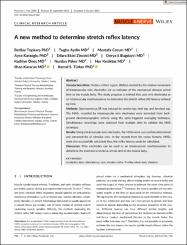| dc.contributor.author | Topkara, Betilay | |
| dc.contributor.author | Aydın, Tuğba | |
| dc.contributor.author | Çorum, Mustafa | |
| dc.contributor.author | Karaoğlu, Ayşe | |
| dc.contributor.author | Ekici Zincirci, Dilara | |
| dc.contributor.author | Buğdaycı, Derya S. | |
| dc.contributor.author | Öneş, Kadriye | |
| dc.contributor.author | Paker, Nurdan | |
| dc.contributor.author | Kesiktaş, Nur | |
| dc.contributor.author | Karacan, İlhan | |
| dc.contributor.author | Türker, Kemal Sıtkı | |
| dc.date.accessioned | 2023-08-11T04:28:30Z | |
| dc.date.available | 2023-08-11T04:28:30Z | |
| dc.date.issued | 2021 | en_US |
| dc.identifier.issn | 0148-639X | |
| dc.identifier.issn | 1097-4598 | |
| dc.identifier.uri | https://hdl.handle.net/11363/5249 | |
| dc.description.abstract | Introduction/Aims: Motion artifact signals (MASs) created by the relative movement
of intramuscular wire electrodes are an indicator of the mechanical stimulus arrival
time to the muscle belly. This study proposes a method that uses wire electrodes as
an intramuscular mechanosensor to determine the stretch reflex (SR) latency without
lag time.
Methods: Gastrocnemius SR was induced by tendon tap, heel tap, and forefoot tap.
The MASs recorded by intramuscular wire electrodes were extracted from background electromyographic activity using the spike-triggered averaging technique.
Simultaneous recordings were obtained from multiple sites to validate the MAS
technique.
Results: Using intramuscular wire electrodes, the MASs were successfully determined
and extracted for all stimulus sites. In the records from the rectus femoris, MASs
were also successfully extracted; thus, the reflex latency could be calculated.
Discussion: Wire electrodes can be used as an intramuscular mechanosensor to
determine the mechanical stimulus arrival time to the muscle belly. | en_US |
| dc.language.iso | eng | en_US |
| dc.publisher | WILEY, 111 RIVER ST, HOBOKEN 07030-5774, NJ | en_US |
| dc.relation.isversionof | 10.1002/mus.27434 | en_US |
| dc.rights | info:eu-repo/semantics/openAccess | en_US |
| dc.rights | Attribution-NonCommercial-NoDerivs 3.0 United States | * |
| dc.rights.uri | http://creativecommons.org/licenses/by-nc-nd/3.0/us/ | * |
| dc.subject | conduction time | en_US |
| dc.subject | reflex latency | en_US |
| dc.subject | tonic vibration reflex | en_US |
| dc.subject | T-reflex | en_US |
| dc.subject | whole-body vibration | en_US |
| dc.title | A new method to determine stretch reflex latency | en_US |
| dc.type | article | en_US |
| dc.relation.ispartof | Muscle & Nerve | en_US |
| dc.department | Diş Hekimliği Fakültesi | en_US |
| dc.authorid | https://orcid.org/0000-0002-0298-1485 | en_US |
| dc.authorid | https://orcid.org/0000-0002-7462-1358 | en_US |
| dc.authorid | https://orcid.org/0000-0001-9962-075X | en_US |
| dc.identifier.volume | 64 | en_US |
| dc.identifier.issue | 6 | en_US |
| dc.identifier.startpage | 726 | en_US |
| dc.identifier.endpage | 733 | en_US |
| dc.relation.publicationcategory | Makale - Uluslararası Hakemli Dergi - Kurum Öğretim Elemanı | en_US |
| dc.contributor.institutionauthor | Topkara, Betilay | |
| dc.contributor.institutionauthor | Karaoğlu, Ayşe | |
| dc.contributor.institutionauthor | Türker, Kemal Sıtkı | |



















